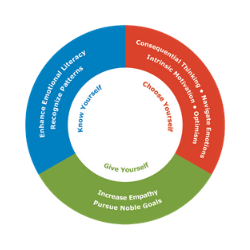Advanced brain imaging technology has shed new light on the neuroscience of innovation – that uniquely human capacity to see a possibility that did not exist and bring it to life.
Researchers looked inside people’s brains as they innovated – jazz musicians improvising melodies, poets writing lines of poetry, and visual artists sketching book cover ideas – with the hope of mapping the regions, circuits or pathways implicated in innovative thinking.
The answer, like the brain itself, is remarkable and complicated. It’s not as simple as identifying specific “innovation pathways,” but the findings do provide invaluable insight for using emotional intelligence to fuel innovative thinking.
Let’s take a look at the research and the real world implications.
Mapping the brain during innovative thinking
People’s ability to innovate is crucial to technological and cultural progress, and in this day and age, maybe even crucial to survival. We’ve entered the Fourth Industrial Revolution, and organizations in every sector have to innovate to survive.
In spite of this reality, the neural architecture of innovative and creative thinking have largely remained a mystery.
To help solve that mystery, a worldwide team of researchers used the latest brain imaging technology to map people’s brains as they came up with new ideas for everyday objects – an imperfect but useful measure of innovative thinking.
The test, known as the alternate uses task, asks people to come up with new and unusual uses for objects. Take a sock, for example. A low score answer would be to keep feet warm – the most common use for a sock – while a highly creative answer would be to use it as a water filtration system.
The study put 163 participants through this test, and as they completed the test they underwent fMRI scans, which measures blood flow to the brain. The researchers then compared the creativity of the answers to the functional activity and connectivity between different brain regions.
So… did they identify an “innovative” region of the brain?
Not exactly. They found that innovative thinking doesn’t stem from one specific brain region, but rather from uncharacteristically strong connections between typically distinct brain regions – the default network, the executive control network, and the salience network. In layman’s terms, innovative thinking occurs when regions of our brain who normally ignore or exclude each other start working together. The results are consistent with recent fMRI studies of professional artists, including jazz musicians improvising melodies1, poets writing new lines of poetry2 and visual artists sketching ideas for a book cover3. And even Einstein’s brain, in a study published in 2014, showed unusually strong connections between different brain regions.
Applying the neuroscience of innovation
To understand how this research applies to the real world, it may be helpful to look at why the brain normally specializes (at the expense of innovation) – because it’s similar to why organizations tend to specialize and work in silos (at the expense of innovation). Basically: It’s efficient. To form and follow previously stored patterns of behavior requires a lot less energy than coming up with new ways. Doing the same thing you’ve always done takes less effort. But these times require something different. In today’s business climate, innovating is no longer a luxury; it’s essential. And just like innovation in the brain stems from getting out of autopilot reactions and thinking in new ways, innovating on an organizational level does, too.
Utilizing emotional intelligence to fuel innovation
If we’re going to apply this science, we need to employ new ways of thinking & connecting. We must be willing to get out of autopilot reactions & be more intentional, and that requires emotional intelligence.
1. Encourage people with different Brain Styles to work together.
People, like regions of the brain, are specialized. Some excel at coming up with new ideas – Visionaries, in Six Seconds’ Brain Styles – while others excel at focusing on the details and getting things done – Deliverers. These are 2 of the 8 Brain Styles – read more about all the brain styles here. The neuroscience research discussed above suggests that innovative thinking comes from an ability to combine the strengths of the different Brain Styles. On an individual level, the most innovative answers came from people who could activate the brain’s default mode network – thought to play a key role in daydreaming, mind wandering and generating ideas – and the executive control network – thought to play a key role in consciously controlling thoughts and evaluating / modifying ideas – at the same time. As an organization, you can promote innovative thinking by encouraging people with different Brain Styles to work together. This is easier said than done. Someone focused on the idealistic big picture and someone focused on getting things done often clash, rub each other the wrong way, and maybe even end up ignoring each other? But like the regions of the brain, breaking down that normal barrier could be the key to innovation.

2. Facilitate communication between typically distinct silos in your organization
It makes sense that Human Resources and Marketing, or Human Resources and Delivery, don’t collaborate on every little thing. Specialization exists for a reason; it’s efficient. But it’s easy to get into a mode where these different units or departments rarely, if ever, communicate. Everyone’s busy. Who has time for an extra meeting? But this research on innovation suggests that this lack of communication could be a real missed opportunity. If your organization has fallen into this trap, try following the Six Seconds Model of EQ to examine those normal practices and consider alternate actions that could be taken to create a more innovative culture.
Know Yourself: What’s the current situation? Is there a lack of interaction between individuals and organizational units?
Choose Yourself: What are your choices for encouraging a more collaborative culture? What are the potential risks and benefits of seeking out more diverse opinions on projects?
Give Yourself: Why does creating a more innovative culture appeal to you? How does it relate to your organization’s Noble Goal?

3. Nurture ideas even if they are incomplete or unrealistic
The brain loves certainty. It loves to be right, to be sure. This tendency can make it hard – as a leader or coworker – to leave space for ideas to grow. It’s too easy to jump on an idea and bring up all the reasons it won’t work, especially when it comes from someone who has a tendency to come up with unrealistic ideas. But innovation stems from the ability to seamlessly switch between dreaming of ideas, examining them, modifying them, and dreaming of other ideas. This means you have to create a culture in which it’s acceptable to advocate for outside-the-box ideas. That doesn’t mean bringing an idea to market that you have grave concerns about, but it does mean listening to that idea and staying open to it even if the timing isn’t right just yet, or one part hasn’t been properly resolved. This leads us into next week’s article on innovation, which focuses on the single most important driver of innovative teams, at least according to Google. Stay tuned for what that is, and if you want to sign up for our weekly email to make sure you don’t miss it, you can sign up by clicking on Get EQ News on the right.

What’s new in emotional intelligence?
How Emotional Intelligence Drives Personal, Social, and Environmental Sustainability
Discover how emotional intelligence is the missing link to achieving sustainability—personally, socially, and environmentally—in a world facing emotional recession and AI-driven burnout.
The Power of Gratitude: How Focusing on the Good Changes Your Brain—and Your Life
Gratitude is more than a warm feeling. It’s a practice that changes how we relate to the world. How can you tap into the power of gratitude?
The Motivation Iceberg: 3 Tips to Unleash Motivation
How do you use emotional intelligence to fuel lasting motivation? The Motivation Iceberg is a simple, clear model for understanding how to motivate – even in WFH during a pandemic.
Stressed Out? 4 EQ Strategies for the End of the World (or Just a Bad Week)
Feeling overwhelmed? Discover four emotional intelligence strategies—from managing spirals to joy-snacking—that can help you navigate stress and tough times with clarity, resilience, and care.
How to Control Emotions Without Shutting Them Down: A 3-Step Process That Actually Works, and the Neuroscience Behind the Technique
How can you control your emotions without shutting them down? The answer is Navigating Emotions. Discover a science-backed 3-step VET method to manage emotions with emotional intelligence, reduce reactivity, and build resilience. Based on neuroscience and the Adaptive Theory of Emotions.
How to Thrive in a BANI World: Insights from the World’s Largest Study of Emotional Intelligence
Emotional intelligence is declining just when we need it most. Drawing from the the world’s largest EQ study, this article explores why and how to reverse the trend—with women leading the way toward emotionally intelligent leadership.
- Pursue Noble Goals in the Six Seconds Model of EQ - July 29, 2023
- Increase Empathy in the Six Seconds Model of EQ - July 26, 2023
- Exercise Optimism - July 24, 2023






